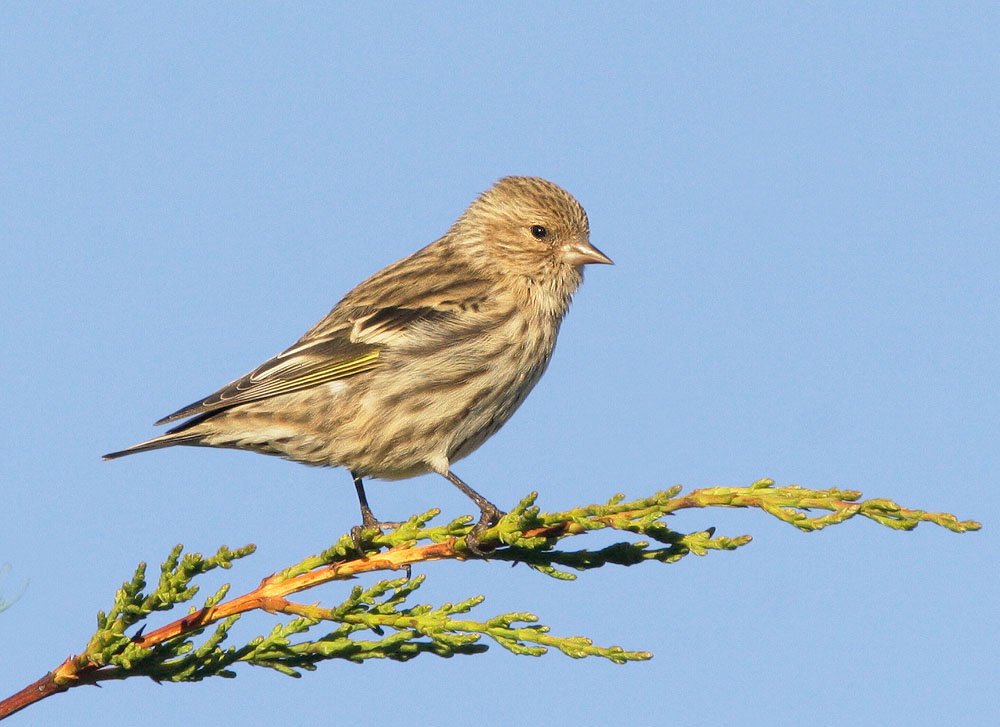Pine Siskin
by Dave Zittin
Every once in a while Pine Siskins appear in our backyard. These birds “irrupt” or move into areas in great numbers where food is abundant. These irruptive flights occur in the winter and are caused by poor availability of food over their northern range.
Pine Siskins are members of the Fringillidae family, which is a widely distributed and diverse group that includes the American Goldfinch, the Hawaiian honeycreepers, and the Neotropical euphonias, and more. Most members of this family are exclusively seed, fruit, and vegetable eaters. Pine Siskins are in the genus Spinus (20 species), which locally includes Lawrence's Goldfinch, the Lesser Goldfinch, and the American Goldfinch.
Pine Siskin showing sharply pointed bill, thin yellow lines in wing and heavy streaking on back and under parts. Photo: Tom Grey
Like other members of their family, Pine Siskins are mostly vegetarian and feed on seeds of conifer and deciduous trees such as alder, birch, sweet gum (Liquidambar), and maple. They also eat fresh buds of various plants and wild sunflower seeds.
Interestingly, Pine Siskins consume salt from various sources, which suggests that their vegetative diet lacks minerals. Some are killed by road traffic in winter when they consume salt used to melt ice and snow.
Pine Siskins tolerate freezing cold winters provided they obtain sufficient food to maintain their metabolism. Unlike hummingbirds, which lower their metabolism as an adaptation to cold (torpor), Pine Siskins raise their metabolism—as much as five times over baseline—to tolerate temperatures as low as -70 degrees Fahrenheit. This requires a lot of food. Compared with their close relatives, Pine Siskins can store more body fat, which helps them withstand the cold. They also store up to 10% of their body weight in food in their crop, a specialized throat pouch. This storage provides 4-5 hours of additional energy to help them through cold nights. Observations suggest that Pine Siskins feed at night when there is bright moonlight which could help them make it through the cold until sunrise.
At feeders, they attack birds larger than themselves including Purple Finch and House Finch. I have even seen them attack and chase away much larger Evening Grosbeaks in the Sierra Nevada Mountains. Their sharply pointed beaks make effective, and I am sure painful, prods to incentivize other birds to get out of the way. If they are unable to open seeds, they will not chase away birds that can crack the shells, expose the seed and provide them with scraps.
Pine Siskins demonstrate strong flocking characteristics throughout the year, even when foraging during the breeding season. When we were in rural Colorado, a large flock descended on a stand of waist-high composite plants and in every imaginable position, much like chickadees.
Pine Siskins can carry and spread salmonella at feeders. It’s important to always sanitize feeders regularly, but when a salmonellosis outbreak occurs, removing feeders to disperse birds is important to reduce the spread of this lethal disease. Read more about salmonellosis outbreaks and on cleaning feeders here: https://scvas.org/backyard-bird-blog/salmonellosis.
Attracting Pine Siskins to Backyards
Any feeder containing seeds, especially hulled seed chips, will work. Pine Siskins especially like nyjer and black sunflower seeds. Composites such as dandelions, and sunflowers will also draw Pine Siskins to your backyard.
Lesser Goldfinch (top) and Pine Siskin (bottom). Photo: John Richardson
Description
The Pine Siskin is a small and streaky finch with a thin, sharply pointed bill and a notched tail. It has two dusky wing bars that fade to white over time. Flight feathers have yellow bases, which are obvious in flight but otherwise mostly concealed. These yellow bases often show up as inconspicuous, thin yellow lines on the wing when they are at rest.
Distribution
The Pine Siskin is a challenging research subject because of its unpredictable migration patterns and the apparent low fidelity to specific breeding areas. Lack of food in the northern part of their range likely triggers irruptions elsewhere. Pine Siskins occur over most of the United States and north into Canada and south into northern Mexico.
Similar Species
Compared with other members of the genus Spinus in Santa Clara County, the Pine Siskin is the only member with conspicuous streaking on its underparts. Its tiny size, very sharp, pointed bill and the yellow base of its flight feathers make it easy to identify. The yellow is conspicuous in flight and sometimes apparent on the wing as thin yellow lines when the bird is at rest. The female House Finch, which can appear similar to the Pine Siskin, has heavy streaking on her underparts but will never have yellow on the wings. The bill of the female House Finch is conical instead of long, narrow and pointed like that of the Pine Siskin.
Explore
Salmonellosis outbreaks and cleaning feeders - Santa Clara Valley Audubon
Safe bird feeding - All About Birds
Cleaning your feeders - Feeder Watch
Songs and calls - All About Birds
Photo showing yellow on flight feathers, heavy streaking and sharp pointed bill.
Photo of flying Pine Siskin showing yellow bases of flight feathers on wings and tail
Distribution map - All About Birds
“Pine Siskins Have Taken Over the Country” - National Audubon
More Backyard Bird Information
View more common Santa Clara County Backyard Birds
Visit our Backyard Birding page
Tell us what you’re seeing in your yard! Send your notes, photos, and sound clips to backyardbirds@scvas.org. We’ll feature your submittals on our website.
Banner Photo: Pine Siskin by Brooke Miller



